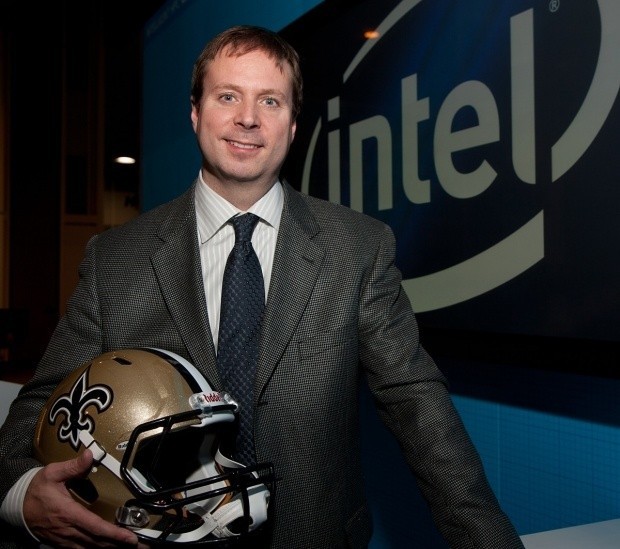HIGHLIGHTS
- Intel collaborated with several industry experts to improve football helmet safety by using Intel technology-based supercomputers and workstations to simulate a human brain's reaction to collisions.
- Intel worked with Mayo Clinic on faster diagnostics of medical scans using upcoming supercomputing chip design called "Intel MIC" ("Mike") so players spend less time on the bench and more time on the field.
- Future technologies could include helmets with built-in Intel® Atom™ chips that measure and feed real-time data to medical personnel
NEW ORLEANS, Nov. 15, 2010 - Intel Corporation today announced that it is collaborating with industry experts and several universities to tackle the issue of football-related head injuries.
Using supercomputers and workstations based on present and future Intel processor technology, researchers are simulating collisions to study the impact on the brain, and use that information to design new football helmets that reduce the risk of short- and long-term injuries.
Kirk Skaugen, Intel vice-president and general manager of the Data Center Group poses with a New Orleans Saints football helmet.
Intel, working with Riddell, the premier designer and developer of helmets and protective equipment, and researchers from the Thayer School of Engineering (Dartmouth), Wayne State University, University of Northern Colorado and Texas State University-San Marcos, demonstrated simulations during an event at the SC10 conference in New Orleans.
In this demonstration, simulated impacts are processed on Intel® Xeon® Processor-based Workstations and Clusters, or a group of linked computers, to rapidly compute, visualize and assess the risk of injury in an impact event. The simulations are based on computer models from partner universities, some of which include actual data from on-field impacts using the Riddell HITS (Head Impact Telemetry System), a proprietary in-helmet technology that provides real-time data regarding head impacts. These models show visualization of the stresses on the brain and can allow for comparisons between impacts that are found to result in a concussion and similar impacts that cause no injury.
"Computer simulations have been instrumental in designing improved brain injury criteria," said Dr. Igor Szczyrba with the University of Northern Colorado. "In the near future, they can also help doctors diagnose actual brain injuries."
Separately, attending the event and discussing the importance of using safe equipment to prevent injuries, was Drew Brees, quarterback of the New Orleans Saints and Super Bowl XLIV MVP.
While no equipment can prevent 100 percent of injuries, Intel is also working with Mayo Clinic to accelerate the ability to process medical scans. In this application, cranial scans running on Intel® Many Integrated Core (MIC) architecture co-processors were accelerated by up to 18 times.
During the event, Intel also discussed future technologies, based on its Intel® Atom™ processors, which could be embedded in helmets and wirelessly feed data into servers and cloud networks that measure injury risk and impact in real-time. When combined with impact simulation, this could better safeguard players by identifying potential injuries quickly so that medical personnel can respond faster and have information as soon as they reach the player on the field.
Intel, with its top-ranked Intel® Xeon® chip-based supercomputers, has been a leader in using parallel processing to solve complex problems. Some of this urgent and groundbreaking research is made possible by Intel® MIC architecture, which could run up to trillions of calculations per second, and includes in its targets high-performance computing segments such as scientific research, exploration and climate modeling. The first Intel MIC product, codenamed "Knights Corner," will be made on Intel's 22-nanometer (nm) manufacturing process - transistor structures packed as small as 22 billionths of a meter -- and will use Moore's Law to scale tens of Intel processing cores on a single chip. While the vast majority of workloads will still run best on award-winning Intel Xeon processors, Intel MIC architecture will add more business opportunities for highly parallel applications.
Last updated: Jul 27, 2022 at 03:45 am CDT


 United States: Find other tech and computer products like this over at
United States: Find other tech and computer products like this over at  United Kingdom: Find other tech and computer products like this over at
United Kingdom: Find other tech and computer products like this over at  Australia: Find other tech and computer products like this over at
Australia: Find other tech and computer products like this over at  Canada: Find other tech and computer products like this over at
Canada: Find other tech and computer products like this over at  Deutschland: Finde andere Technik- und Computerprodukte wie dieses auf
Deutschland: Finde andere Technik- und Computerprodukte wie dieses auf